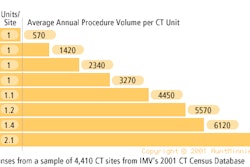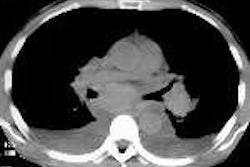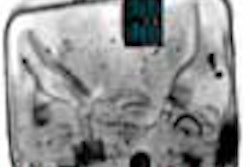CHICAGO - In one of the largest studies to date, British radiologists have found CT colonography to be robust and reliable for the diagnosis of colon cancer in symptomatic patients. Extremely high sensitivity and specificity, except in the case of flat lesions, characterized the results of the five-year study.
"The aim of the study was to look at the sensitivity and specificity of this technique purely for cancer detection and diagnosis" -- not polyp detection -- said study author Dr. William Lees from University College of London and Middlesex Hospital. "We were also interested in looking at the robustness of the technique, in terms of compliance and technical failure rates. Because, although we know that colonoscopy is our gold standard, in routine clinical practice -- especially in elderly patients -- failure rates are still extremely high."
Over a five-year period of offering a routine CT colonography service, Dr. Lees and his colleagues studied 1400 symptomatic patients.
CT diagnosis was tested against colonoscopy, laparotomy, or a minimum of six months’ clinical follow-up. Every diagnosed case of colorectal cancer was reviewed in this multidisciplinary fashion.
"Because this is a clinical series looking at all of our patients, in practice we have to offer two levels of examination," Lees said. "The routine level 1 is reviewed with rapid paging and multiplanar reformatting (MPR), with VC [virtual colonoscopy] available for all of these patients, but only routinely used for spot examinations of suspicious areas turned up on MPR."
Staging was also included as part of the process, with the liver examined in the portal phase, and staging of rectal and colorectal cancer.
The patients first underwent standard bowel preparation, with fecal marking used as an alternative for some elderly or weak patients.
Using a single-detector spiral scanner for the first 1,000 patients, and a Somatom Plus 4 Volume Zoom (Siemens, Erlangen, Germany) multidetector-row scanner for the last 400, each patient underwent an abdominal CT imaging protocol, most in both supine and prone positions.
For single-slice CT, supine scan data was acquired with collimation of 5 mm or smaller, pitch 1.5, and reconstruction at 2-mm increments, following injection of 100 ml of intravenous contrast at a rate of 5 mm/sec, followed by prone scans of the pelvis and lower abdomen. Multislice CT images were acquired 1.25-mm collimation, pitch of 1, and reconstruction at 1 mm, Lees said. Siemens’ proprietary software and other applications were used to analyze the data.
"We make heavy use of orienting our multiplanar reformatting along the axis of the bowel, and performing curved MPR in very many cases," Lees said, adding that the technique that is particularly useful in staging and for differential diagnosis.
"You're all very familiar with VC, but I think the most important aspect is the interactive manipulation of lesions that have been detected with MPR, all in VC mode, to help determine the reality of polyps [as] differentiated from stool," he said.
So far, the team has found 259 cancers, 255 of which were seen in CT colonography. Three of the lesions were missed early in the first 200 cases; two were Duke’s A flat cancers found at colonoscopy, and 1 was a malignant polyp hidden in residue that was later discovered in a subsequent CT colography exam when the bowel had been better prepared, Williams said.
There were 16 false positives, 14 of which were inflammatory lesions, mainly diverticulitis. In addition, 7 patients failed to complete the preparation, 3 refused to have their rectums intubated, and another 24 missed outpatient appointments. About 7% of the studies were considered suboptimal, due mainly to the inability to obtain prone and supine views, lack of IV access, and poor bowel prep.
Overall, the technique was 98.5% sensitive and 98.2% specific for the diagnosis of colon cancer.
"Perhaps the main criticism was that all the lesions that we missed were Duke's A cancers," which have a high cure rate, so the technique is far from perfect, he said. "But interestingly, we found two flat cancers with VC that we weren't [able] to see in MPR."
By Eric Barnes
AuntMinnie.com staff writer
November 26, 2001
For the rest of our coverage of the 2001 RSNA meeting, go to our RADCast@RSNA 2001.
Copyright © 2001 AuntMinnie.com



















